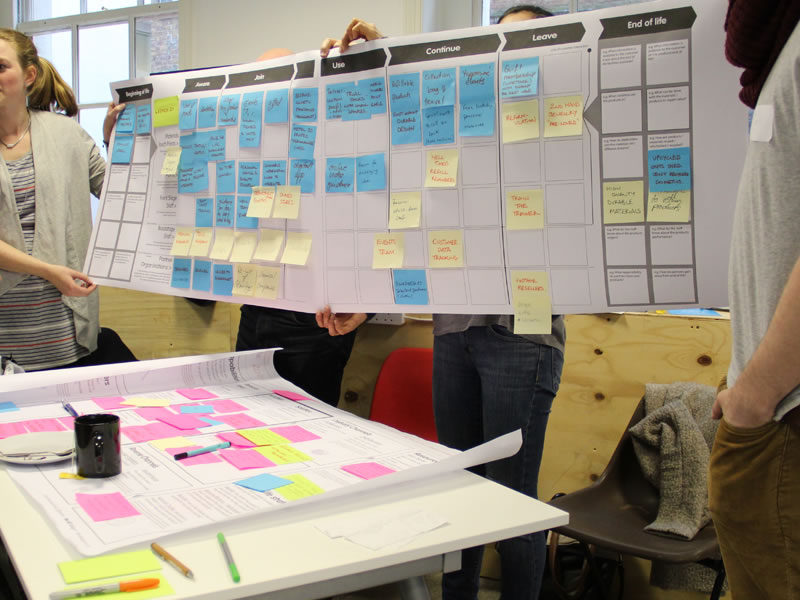By Rob Maslin
Director of We All Design
Course Tutor for Innovation and Service Design for Designers and Innovation and Design Thinking for Businesses, Entrepreneurs and Nonprofit
Good design puts people at the centre of solutions. Good design is able to answer unspoken problems that the users themselves may not be aware of or able to articulate. But often that is only possible if designers are able to position themselves to explore solutions or approaches that businesses themselves don’t know they need before they set the brief. The unspoken and unknown needs of the client precede the user.

Service blue printing, a tool used to describe different levels of a service and how they interact over the course of a service experience. Blue prints can be used at the research or development phase of design.
I recently bumped into a friend (the first service designer I ever met), who just moved to London. She reminded me of something I said when we first met 7-8 years ago. It is the reason I eventually found my way into service design, which still drives me today:
“Clients design the world, because they set the briefs.”
Actually I just repeated someone else (Alastair Fuad-Luke) from a conference I’d been to earlier that day. The point perfectly summed up something I had been grappling with for a long time. I wanted to tackle problems and make a positive contribution to the environment and society.
It has long been claimed in various articles and papers that 80% of a product’s environmental impact is determined at the design phase. But I dispute that. Most designers want to have a positive impact, but only a few dedicated people find themselves in a position to make a difference.
Speaking as a former product/packaging designer the problem/solution that could make a difference was always out of reach partly because it wasn’t necessarily a ‘thing’.
The problems are twofold: Design disciplines often define themselves not by the problems they solve but by the outcomes they produce. Given the same problem – for example, increasing recycling rates of plastic – a graphic designer and a product designer would create distinctly different solutions. The second issue is that once the client has decided to approach a designer for a project, the solution is already predetermined by the expected outcome often before the core problem or opportunity is understood.
Lots of business, sustainability and social challenges can be described as wicked problems, meaning some attempt to solve them has to be made before they are understood. Therefore that is where design should start, when the brief is being shaped.
Meaningful change to the quality of people’s experience, environmental impact and businesses profit is created by designing the right things and working out how to create a joined up system where the parts are coordinated to create more value collectively that they could in isolation.
This is one thing that service design and design thinking do really well, as well as expand on the list of things that need to be designed including: What users need to do. The skills and actions of a company’s frontline staff. The activities of their supporting managers and the values and purpose of the company passed down by the CEO.
To reach the important environmental social and business challenges that give the best return on investment, design often needs to work upstream of business’s expectations. Even today we still find businesses do not realise how much more value can be gained from designers accessing every part of a business with a view to building cohesive solutions.
The only way to reach these issues and use the businesses’ knowledge and the designers’ skills is to build relationships which focus on working with clients, instead of for them. We often do this by working in our clients’ offices to share the serendipitous moments, present research that builds empathy, and run co-creative workshops that help build solutions with their expertise.

A desktop walk through. This example was used to build services for music festivals with the staff who deliver them.
The processes we use help to both create solutions that staff believe in and embed the skills into organisations that help make everyday business decisions to support those solutions in the long-term.
Where next? Phillippa Rose and I are now preparing to co-lead two summer school courses at LCC: one for designers looking to make the move into service design, and one for business people looking to understand how they can bring service design into their organisation or build on their professional skills and maybe become service designers.
The plan is to bring the two cohorts together at key points to collaborate and understand the different perspectives of people with different backgrounds. We will then be splitting the groups to help attendees reflect and understand how their skills and past experiences can shape the way their organisations deliver outstanding customer experiences in the future.
Read more about LCC’s summer schools for professionals and book your place
Tweet course leaders @RobMaslin and @phillirose with your questions about the course during our #LCC_SummerSchool live Twitter chat on Tuesday 10 May, 6-7pm.


